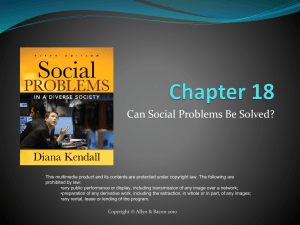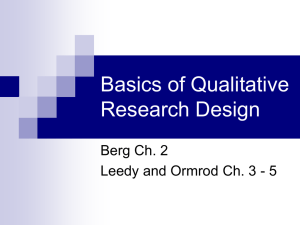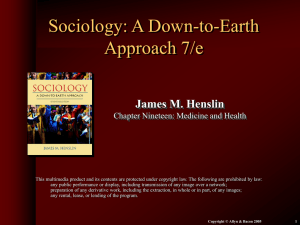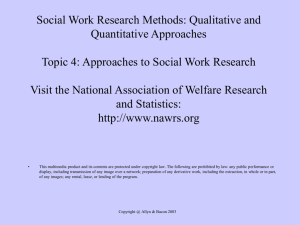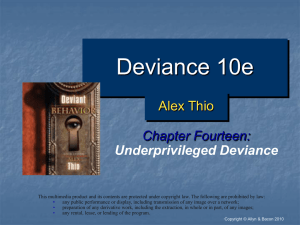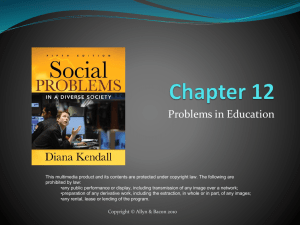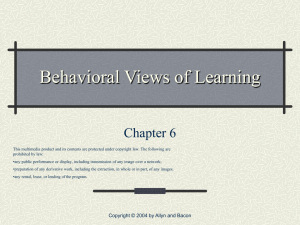Lecture Ch8
advertisement
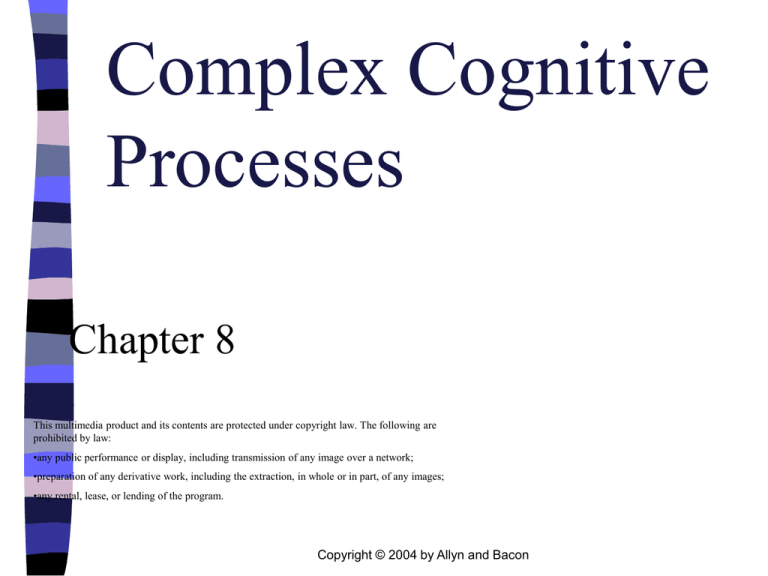
Complex Cognitive Processes Chapter 8 This multimedia product and its contents are protected under copyright law. The following are prohibited by law: •any public performance or display, including transmission of any image over a network; •preparation of any derivative work, including the extraction, in whole or in part, of any images; •any rental, lease, or lending of the program. Copyright © 2004 by Allyn and Bacon Overview Learning and Teaching about Concepts Problem Solving Becoming an Expert Student – Learning strategies Teaching for Positive Transfer Copyright © 2004 by Allyn and Bacon Chapter 8 Teaching for Transfer Importance of Understanding Complex Cognitive Processes Becoming an Expert Student Problem Solving Learning & Teaching about Concepts Copyright © 2004 by Allyn and Bacon Learning and Teaching Concepts Most of what we know about the world is a result of our understanding of concepts and concept relationships = Manageable life Concepts are – categories of similar ideas, events, objects, people, etc. (e.g., student) – abstractions. – ways to organize information. Copyright © 2004 by Allyn and Bacon View of Concept Learning Defining attribute or distinctive feature (traditional view) – E.g., book – May not be clear-cut, but you can recognize one (e.g., party) Prototype: Representative member of the concept (bird: turkey vulture?; fruit: olive?) – Graded membership (better or worse examples) Exemplars – Actual memories Schemas - help us recognize concepts Copyright © 2004 by Allyn and Bacon Strategies for Teaching Concepts Concept attainment • One of these things is not like the others, one of these things doesn’t belong. – – – – – Examples Non-examples Hypothesis Compare & contrast Concept constructed through discussion Copyright © 2004 by Allyn and Bacon Strategies for Teaching Concepts – Four essential components 1. Examples and non-examples – Consider difficulty, age, ability 2. Relevant and irrelevant attributes – E.g., not all birds fly (penguins, ostriches) 3. Name of the concept – Label does not equal understanding (isosceles triangle) 4. Definition of the concept – General category (fruit) – Defining attributes (seeds in the part we eat) Bonus: Use visual aids to help clarify Copyright © 2004 by Allyn and Bacon Concept Attainment Lesson Structure Phase 1: Presentation of Data and Identification of Concept – Present labeled examples/non-examples • Undergeneralization (too narrow/red fruit) • Overgeneralization (too broad/ things we eat) – Students compare negative and positive examples – Students generate and test hypotheses – Students state a definition of the concept Copyright © 2004 by Allyn and Bacon Concept Attainment Lesson Structure Phase 2: Testing Attainment of the Concept – Students identify additional unlabeled examples as “yes” or “no” – Teacher confirms hypothesis, names concept, restates definition – Students generate examples Copyright © 2004 by Allyn and Bacon Concept Attainment Lesson Structure Phase 3: Analysis of Thinking Strategies – Students describe their thoughts • How did I get here? – Students discuss role of hypothesis and attributes – Students discuss type and number of hypotheses Copyright © 2004 by Allyn and Bacon Keys to Teaching Concepts Less obvious examples help prevent undergeneralization (open your mind) Non-examples help prevent overgeneralization (can’t be everything) Concept mapping can help connect the new concept to other concepts they know = advancement of knowledge (intelligence?) Copyright © 2004 by Allyn and Bacon Lab Assignment – Prepare a lesson plan to teach a concept 1.Choose a concept. 2.Identify a prototype. 3.Are there defining attributes? 4.Identify examples and non-examples. 5.What are the irrelevant attributes? 6.What thinking was required to analyze your chosen concept? 7.How will you evaluate your students’ attainment of the concept? Copyright © 2004 by Allyn and Bacon Teaching Concepts through Discovery - Jerome Bruner Understanding the structure of the subject Teacher presents examples Students discover the interrelationships Inductive reasoning (eg-rule method/fruit ex.) – Formulating general principles based on knowledge of examples and details Requires intuitive thinking (make guesses & refine; is this encouraged? *Guided vs. unguided discovery approaches Copyright © 2004 by Allyn and Bacon Teaching Concepts through Exposition/Explanation – David Ausubel Knowledge through reception rather than discovery (more passive style) Focus on meaningful verbal learning( not rote memorization). Make the connections & build. Learning progresses deductively (rule-eg method/broad to specific) Copyright © 2004 by Allyn and Bacon Learning Strategies –big plan comprised of tactics Deciding what is important – “Have the experience but miss the meaning.” (missing the central idea) Creating summaries - An acquired skill Underlining and highlighting - Be selective Taking notes – Focuses attention – External storage for later review – In some cases it may distract Copyright © 2004 by Allyn and Bacon Visual Tools for Organizing identifying connections and relationships between concepts Maps and charts Venn or tree diagrams Timelines Reading strategies * be sure you review these in your text – READS – PQ4R – CAPS – KWL You have to teach the strategies if you want them to be of value to your students. Copyright © 2004 by Allyn and Bacon Teaching to Encourage Transfer: previous learning affects current problem solving = a useable knowledge base Make learning meaningful & useful Practical applications: link to real life problem solving (can’t wake up in a new world everyday) Context – learning may be bound by context or situation. How can you avoid this? “Why do we need algebra?” Teach critical thinking skills – to apply in changing situations Overlearning = greater transfer and increased speed of processing Copyright © 2004 by Allyn and Bacon Stages of Transfer Acquisition Phase – Teach a new strategy and how to use it Retention Phase – Practice a strategy; Give feedback Transfer Phase – Give new problems; Use the same strategy EXAMPLE: identifying topic sentences How would you teach this skill? Copyright © 2004 by Allyn and Bacon


